Allies of World War I
| Allies of World War I | ||||||||
| Military alliance | ||||||||
| ||||||||
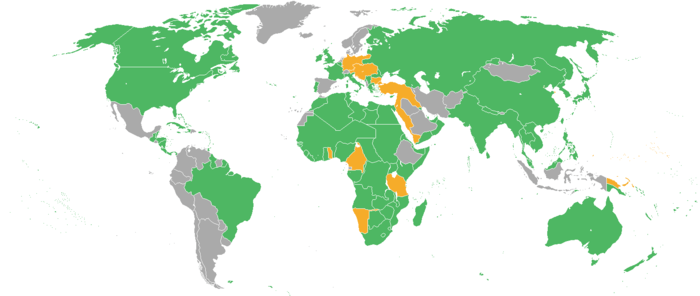
| ||||||||
| Capital | Not specified | |||||||
| Political structure | Military alliance | |||||||
| Historical era | World War I | |||||||
| • | Established | 1914 | ||||||
| • | Disestablished | 1918 | ||||||
| ||||||||
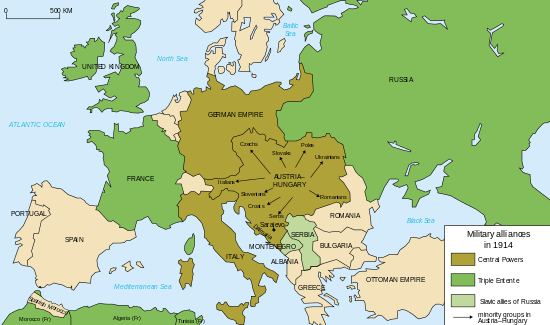
The Allies of World War I were the countries that opposed the Central Powers in the First World War.
The members of the original Entente Alliance of 1907 were the French Republic, the British Empire and the Russian Empire. Italy ended its alliance with the Central Powers, arguing that Germany and Austria-Hungary started the war and that the alliance was only defensive in nature; it entered the war on the side of the Entente in 1915. Japan was another important member. Belgium, Serbia, Greece, Montenegro, and Romania[1] were affiliated members of the Entente.[2]
The 1920 Treaty of Sèvres defines the Principal Allied Powers as the British Empire, French Republic, Italy and Japan. The Allied Powers comprised, together with the Principal Allied Powers, Armenia, Belgium, Greece, Hejaz, Poland, Portugal, Romania, Serb-Croat-Slovene state and Czechoslovakia.[3]
The U.S. declaration of war on Germany in April 1917 was on the grounds that Germany had violated its neutrality by attacking international shipping and the Zimmermann Telegram sent to Mexico.[4] It declared war on Austria-Hungary in December 1917.[5][6] The U.S. entered the war as an "associated power", rather than as a formal ally of France and the United Kingdom, in order to avoid "foreign entanglements".[7] Although the Ottoman Empire and Bulgaria severed relations with the United States, neither declared war.[8]
The Dominions and Crown Colonies of the British Empire made great contributions to the Allied war effort, but did not have independent foreign policies in World War I with the British War Cabinet exercising operational control of British Empire forces. The Dominion governments did control recruiting, and removed personnel from front-line duties as they saw fit. From early 1917, the War Cabinet was superseded by the Imperial War Cabinet, which had Dominion representation. The Australian Corps and Canadian Corps were placed under the command of Australian and Canadian Lieutenant Generals John Monash and Arthur Currie,[9] respectively, who reported in turn to British generals. In April 1918, operational control of all Entente forces on the Western Front passed to the new supreme commander, Ferdinand Foch of France.
History

The original alliance opposed to the Central Powers was the Triple Entente, which was formed by three Great European Powers:
The war began with the Austrian attack invasion of Serbia on 28 July 1914, in response to the assassination of Archduke Franz Ferdinand. The Austrian Empire followed with an attack on the Serbian ally Montenegro on 8 August. On the Western Front, the two neutral States of Belgium and Luxembourg were immediately occupied by German troops as part of the German Schlieffen Plan.
Of the two Low Countries involved in the war, Luxembourg chose to capitulate, and was viewed as a collaborationist state by the Entente powers: Luxembourg never became part of the Allies, and only narrowly avoided Belgium's efforts of annexation, at the conclusion of hostilities in 1919. On 23 August Japan joined the Entente, which then counted seven members. . The entrance of the British Empire brought Nepal into the war.
On 23 May 1915, Italy entered the war on the Entente side and declared war on Austria; previously, Italy had been a member of the Triple Alliance but had remained neutral since the beginning of the conflict. In 1916, Montenegro capitulated and left the Entente, and two nations joined, Portugal and Romania.
On 6 April 1917, the United States entered the war. Liberia, Siam and Greece also became allies. After the October Revolution, Russia left the alliance and ended formal involvement in the war, by the signing of the treaty of Brest Litovsk in November effectively creating a separate peace with the Central Powers. This was followed by Romanian cessation of hostilities, however the Balkan State declared war on Central Powers again on 10 November 1918. The Russian withdrawal allowed for the final structure of the alliance, which was based on five Great Powers:
Following the Versailles conference, Britain, France, Italy and Japan became the permanent members of the League of Nations council. The United States, meant to be the fifth permanent member, left because the US Senate voted on 19 March 1920 against the ratification of the Treaty of Versailles, thus preventing American participation in the League.
| Population (millions) |
Land (million km2) |
GDP ($ billion) | ||||
|---|---|---|---|---|---|---|
| First Wave: 1914 | ||||||
| Russia | Russian Empire (inc. Poland) | 173.2 | 21.7 | 257.7 | ||
| Finland | 3.2 | 0.4 | 6.6 | |||
| Total | 176.4 | 22.1 | 264.3 | |||
| French Third Republic | France | 39.8 | 0.5 | 138.7 | ||
| French colonies | 48.3 | 10.7 | 31.5 | |||
| Total | 88.1 | 11.2 | 170.2 | |||
| British Empire | United Kingdom | 46.0 | 0.3 | 226.4 | ||
| British colonies | 380.2 | 13.5 | 257 | |||
| British Dominions | 19.9 | 19.5 | 77.8 | |||
| Total | 446.1 | 33.3 | 561.2 | |||
| Empire of Japan | Japan | 55.1 | 0.4 | 76.5 | ||
| Japanese colonies[11] | 19.1 | 0.3 | 16.3 | |||
| Total | 74.2 | 0.7 | 92.8 | |||
| Yugoslav states[12] | 7.0 | 0.2 | 7.2 | |||
| Second Wave (1915–16) | ||||||
| Kingdom of Italy | Italy | 35.6 | 0.3 | 91.3 | ||
| Italian colonies | 2.0 | 2.0 | 1.3 | |||
| Total | 37.6 | 2.3 | 92.6 | |||
| Portugal | Portugal | 6.0 | 0.1 | 7.4 | ||
| Portuguese colonies | 8.7 | 2.4 | 5.2 | |||
| Total | 14.7 | 2.5 | 12.6 | |||
| Kingdom of Romania | 7.7 | 0.1 | 11.7 | |||
| Third Wave (1917–18) | ||||||
| United States | United States | 96.5 | 7.8 | 511.6 | ||
| overseas dependencies[13] | 9.8 | 1.8 | 10.6 | |||
| Total | 106.3 | 9.6 | 522.2 | |||
| Central American states[14] | 9.0 | 0.6 | 10.6 | |||
| Brazil | 25.0 | 8.5 | 20.3 | |||
| Kingdom of Greece | 4.8 | 0.1 | 7.7 | |||
| Siam | 8.4 | 0.5 | 7.0 | |||
| Republic of China | 441.0 | 11.1 | 243.7 | |||
| Liberia | 1.5 | 0.1 | 0.9 | |||
| Population (millions) |
Territory (million km2) |
GDP ($ billion) | |||
|---|---|---|---|---|---|
| November 1914 | |||||
| Allies, total | 793.3 | 76.5 | 1,096.5 | ||
| UK, France and Russia only | 259.0 | 22.6 | 622.6 | ||
| November 1916 | |||||
| Allies, total | 793.3 | 67.5 | 1,213.4 | ||
| UK, France and Russia only | 259.0 | 22.6 | 622.6 | ||
| November 1918 | |||||
| Allies, total | 1,271.7 | 80.8 | 1,760.5 | ||
| Percentage of world | 70% | 61% | 64% | ||
| UK, France and USA only | 182.0 | 8.7 | 876.6 | ||
| Percentage of world | 10% | 7% | 32% | ||
| Central Powers[16] | 156.1 | 6.0 | 383.9 | ||
| World, 1913 | 1,810.3 | 133.5 | 2,733.9 | ||
Major affiliated state combatants
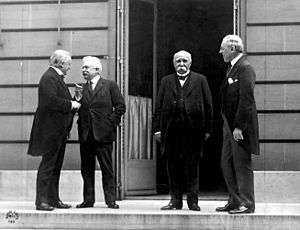
United Kingdom


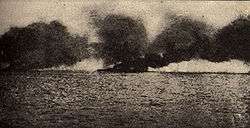

War justifications
In response to the Germans invasion of neutral Belgium, the United Kingdom declared war on Germany on 4 August 1914.[17] The British Empire held several semi-autonomous dominions that were automatically brought into the war effort as a result of the British declaration of war, including Australia, Canada, New Zealand, Newfoundland, and South Africa.
Colonies and dependencies
In Europe
Gibraltar, Cyprus and Malta were British dependencies in Europe.
In Africa
The UK held several colonies, protectorates, and semi-autonomous dependencies at the time of World War I. In Eastern Africa the East Africa Protectorate, Nyasaland, both Northern and Southern Rhodesia, the Uganda Protectorate, were involved in conflict with German forces in German East Africa. In Western Africa, the colonies of Gold Coast and Nigeria were involved in military actions against German forces from Togoland and Kamerun. In Southwestern Africa, the semi-autonomous dominion of South Africa was involved in military actions against German forces in German South-West Africa.
In North America
Canada and Newfoundland were two autonomous dominions during the war that made major military contributions to the British war effort.
Other British dependent territories in the Americas included: British Honduras, the Falkland Islands, British Guiana, and Jamaica.
In Asia
The UK held large possessions in Asia, including the Indian Empire which was an assortment of British imperial authorities in the territory now defined as India, Bangladesh, Burma, and Pakistan.
Other British territories at the time included: British Malaya – referring to several Malay states under British control as a result of the Straits Settlements, North Borneo, Sri Lanka, and Hong Kong.
In Oceania
Australia and New Zealand were two autonomous dominions of the UK in Oceania during the war. Australia had become an independent nation state in 1901. Having strong cultural ties with the United Kingdom, the nations declared war on Germany on 4 August 1914.
Russia

In response to Austria-Hungary's invasion of Serbia in 1914, Russian government officials denounced the Austro-Hungarian invasion as an "ignoble war" on a "weak country".[18] Russian government official Nikolaĭ N. Shebeko stated: "the attack on Serbia by a powerful empire such as Austria, supposedly in order to defend its existence, cannot be understood by anyone in my country; it has been considered simply as a means of delivering a death-blow to Serbia."[18] Russia held close diplomatic relations with Serbia, and Russian foreign minister Sergey Sazonov suspected the events were a conspiracy between Austria-Hungary and Germany to expel Russian influence in the Balkans.[18] On 30 July 1914, Russia enacted a general mobilization. The day after general mobilization was enacted, Austria-Hungary's ally Germany declared war on Russia prior to expected Russian intervention against Austria-Hungary.
Following a raid by Ottoman warships on the Russian port of Odessa, Russia declared war on the Ottoman Empire in November 1914.[19]
France
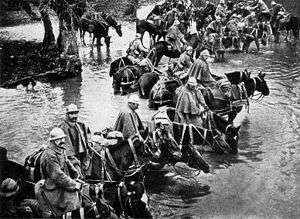
After Germany declared war on Russia, France with its alliance with Russia prepared a general mobilization in expectation of war. On 3 August 1914, Germany declared war on France.[20]
Japan

Japan declared war on Germany after it did not accept an ultimatum sent by Japan to Germany, demanding that Germany extinguish its title to the Kiautschou Bay concession and restore that territory to China.[21] The Japanese government appealed to the Japanese public that Japan was not merely entering a "European War" on behalf of European powers, but that Japan was fighting on behalf of Asians against a belligerent European power, Germany, that Japan identified as the "source of evil in the Far East".[21] Thus as a result of this, Japan was following through with the Anglo-Japanese Alliance.[21]
Italy
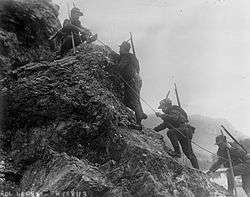
Italy had been a member of the Triple Alliance alongside Germany and Austria-Hungary since the 1880s, however the Triple Alliance stipulated that all parties must be consulted in the event of one country engaging in war and Italy was not informed of this.[22] As such Italy claimed that it was not obligated to join their war effort.[22] Italy's relations with Germany and Austria-Hungary in contrast to the Allies were additionally affected by the fact that in 1913, Britain supplied Italy with 90 percent of its annual imports of coal.[22] The war effort of the Central Powers meant that Germany and Austria-Hungary were using their coal supplies for the war, and little was available to be exported to Italy.[22] Italy initially attempted to pursue neutrality from 1914 to 1915.[22]
After diplomatic negotiations, Britain and France convinced Italy to join the war effort with promises that Italy would gain favourable territorial concessions from the Central Powers, including Italian-populated territories of Austria-Hungary.[23] Italy ordered mobilization on 22 May 1915, and issued an ultimatum to Austria-Hungary, and then declared war on Austria-Hungary, though it did not declare war on Germany.[23]
Serbia

Serbia was invaded by Austria-Hungary after Austria-Hungary placed a stringent ultimatum to the Serbian government demanding full compliance to an Austro-Hungarian investigation of complicity by the Serbian government in the assassination of Archduke Francis Ferdinand. Serbia agreed to most of Austria-Hungary's demands but because it did not fully comply, Austria-Hungary invaded.
Serbia had the diplomatic support of Russia, and both Serbia and Russia resented Austria-Hungary's absorption of Bosnia and Herzegovina that held a substantial Serb population. Serbia had expanded in size through its actions in the Balkan Wars of 1912–1913 when the Ottoman Empire's control in the Balkans collapsed.
During the war, Serbia justified the war as being the result of Austro-Hungarian imperialism towards Serbs and South Slavs, Serbia cooperated with Yugoslavists including the Yugoslav Committee who sought pan-South-Slav unification, particularly through liberating South Slavs from Austria-Hungary. In the Corfu Declaration in 1917, the Serbian government officially declared its intention to form a state of Yugoslavia.
The first two allied victories in the war were won by the Serbian army, on the mountains of Cer and Kolubara, in western Serbia. The Austro-Hungarian army was expelled from the country, suffering heavy losses. Serbia suffered great losses during the war, almost 50% of all men and around 30% of its entire population were killed.
Romania
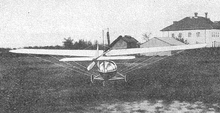

Equal status with the main Allied Powers was one of the primary conditions for Romania's entry into the War. The Powers officially recognized this status through the 1916 Treaty of Bucharest.[24] Romania fought on 3 of the 4 European Fronts: Eastern, Balkan and Italian, fielding in total over 1,200,000 troops.[25]
Romanian military industry was mainly focused on converting various fortification guns into field and anti-aircraft artillery. Up to 334 German 53 mm Fahrpanzer guns, 93 French 57 mm Hotchkiss guns, 66 Krupp 150 mm guns and dozens more 210 mm guns were mounted on Romanian-built carriages and transformed into mobile field artillery, with 45 Krupp 75 mm guns and 132 Hotchkiss 57 mm guns being transformed into anti-aircraft artillery. The Romanians also upgraded 120 German Krupp 105 mm howitzers, the result being the most effective field howitzer in Europe at that time. Romania even managed to design and build from scratch its own model of mortar, the 250 mm Negrei Model 1916.[26]
Other Romanian technological assets include the building of Vlaicu III, the world's first aircraft made of metal.[27] The Romanian Navy possessed the largest warships on the Danube. They were a class of 4 river monitors, built locally at the Galați shipyard using parts manufactured in Austria-Hungary, and the first one launched was Lascăr Catargiu, in 1907.[28][29] The Romanian monitors displaced almost 700 tons, were armed with three 120 mm naval guns in 3 turrets, two 120 mm naval howitzers, four 47 mm anti-aircraft guns and two 6.5 machine guns.[30] The monitors took part in the Battle of Turtucaia and the First Battle of Cobadin. The Romanian-designed Schneider 150 mm Model 1912 howitzer was considered one of the most modern field guns on the Western Front.[31]
Romania's entry into the War in August 1916 provoked major changes for the Germans. General Erich von Falkenhayn was dismissed and sent to command the Central Powers forces in Romania, which enabled Hindenburg's subsequent ascension to power.[32] Due to having to fight against all of the Central Powers on the longest front in Europe (1,600 km) and with little foreign help (only 50,000 Russians aided 650,000 Romanians in 1916),[33] the Romanian capital was conquered that December. Vlaicu III was also captured and shipped to Germany, being last seen in 1942.[34] The Romanian administration established a new capital at Iași and continued to fight on the Allied side in 1917.[35] Despite being relatively short, the Romanian campaign of 1916 provided considerable respite for the Western Allies, as the Germans ceased all their other offensive operations in order to deal with Romania.[36] After suffering a tactical defeat against the Romanians (aided by Russians) in July 1917 at Mărăști, the Central Powers launched two counterattacks, at Mărășești and Oituz. The German offensive at Mărășești was soundly defeated, with German prisoners later telling their Romanian captors that German casualties were extremely heavy, and that they "had not encountered such stiff resistance since the battles of Somme and Verdun".[37] The Austro-Hungarian offensive at Oituz also failed. On 22 September, the Austro-Hungarian Enns-class river monitor SMS Inn was sunk by a Romanian mine near Brăila.[38][39] After Russia signed the Treaty of Brest-Litovsk and dropped out of the War, Romania was left surrounded by the Central Powers and eventually signed a similar treaty on 7 May 1918. Despite being forced to cede land to Austria-Hungary and Bulgaria, Romania ended up with a net gain in territory due to the Union with Bessarabia. On 10 November, Romania re-entered the War and fought a war with Hungary that lasted until August 1919.
Other affiliated state combatants
Belgium
Belgium had declared its neutrality when the war began, but Germany disregarded Belgium's neutrality and invaded the country in order to launch an offensive against the French capital of Paris. As a result, Belgium became a member of the Allies.
Brazil

Brazil entered the war in 1917 after the United States intervened on the basis of Germany's unrestricted submarine warfare sinking its merchant ships, which Brazil also cited as a reason to enter the war fighting against Germany and the Central Powers.
Montenegro
Montenegro had very close cultural and political connections with Serbia and had cooperated with Serbia in the Balkan Wars of 1912–1913. Montenegro joined the war against Austria-Hungary.
Nejd and Hasa
The Emirate of Nejd and Hasa agreed to enter the war as an ally of Britain in the Treaty of Darin on December 26, 1915.[40]
Idrisid Emirate of Asir
The Idrisid Emirate of Asir participated in the Arab revolt. Its Emir, Muhammad ibn Ali al-Idrisi, signed an agreement with the British and joined the Allies in May 1915.

Major co-belligerent state combatants
United States
The United States declared war on Germany in 1917 on the grounds that Germany violated U.S. neutrality by attacking international shipping with its unrestricted submarine warfare campaign.[4] The remotely connected Zimmermann Telegram of the same period, within which the Germans promised to help Mexico regain some of its territory lost to the U.S nearly eight decades before, was also a contributing factor. The U.S. entered the war as an "associated power," rather than a formal ally of France and the United Kingdom, in order to avoid "foreign entanglements."[7] Although the Ottoman Empire and Bulgaria severed relations with the United States, neither declared war.[8]
Non-state combatants
Three non-state combatants, which voluntarily fought with the Allies and seceded from the constituent states of the Central Powers at the end of the war, were allowed to participate as winning nations to the peace treaties:
-
 Armenian irregulars and volunteers: seceded from Soviet Russia in the aftermath of the Russian Revolution and fought against the Ottoman Empire.
Armenian irregulars and volunteers: seceded from Soviet Russia in the aftermath of the Russian Revolution and fought against the Ottoman Empire. -
 Polish Legions
Polish Legions -
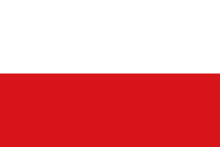 Czechoslovak Legions: armed by France, Italy and Russia
Czechoslovak Legions: armed by France, Italy and Russia
Leaders
.svg.png) Serbia
Serbia
- Peter I – King of Serbia
- Crown Prince Alexander – Regent, Commander-in-Chief
- Nikola Pašić – Prime Minister of Serbia
- Field Marshal Radomir Putnik – Chief of the General Staff of the Serbian Army (1914–1915)
- General / Field Marshal Živojin Mišić – Deputy Chief of General Staff (1914), Commander of First Army (1914–1915; 1917), later Chief of General Staff (1918)
- General / Field Marshal Petar Bojović – Commander of First Army (1914), Deputy Chief of General Staff (1915–1916), Chief of General Staff (1916–1917) later Commander of First Army (1918)
- General / Field Marshal Stepa Stepanović – Commander of Second Army (1914–1918)
- General Pavle Jurišić Šturm – Commander of Third Army (1914–1916)
- Colonel Dušan Stefanović – Minister of War (1914)
- Colonel Radivoje Bojović – Minister of War (1914–1915)
- Colonel / General Božidar Terzić – Minister of War (1915–1918)
- General Mihailo Rašić – Minister of War (1918)
- Colonel / General Miloš Vasić – Commander of First Army (1916; 1917), Commander of Third Army (1916)
 Montenegro
Montenegro
- Nicholas I – King of Montenegro, Commander-in-Chief
- General Serdar Janko Vukotić – Prime Minister, Commander of 1st Montenegrin Army
.svg.png) General Božidar Janković – Chief of the General Staff of the Montenegrin Army (1914–1915)
General Božidar Janković – Chief of the General Staff of the Montenegrin Army (1914–1915).svg.png) Colonel Petar Pešić – Deputy Chief of the General Staff of the Montenegrin Army (1914–1915), later Chief of the General Staff of the Montenegrin Army (1915–1916)
Colonel Petar Pešić – Deputy Chief of the General Staff of the Montenegrin Army (1914–1915), later Chief of the General Staff of the Montenegrin Army (1915–1916)- Crown Prince Danilo II Petrović-Njegoš – In the staff of the 1st Montenegrin Army
- Brigadier Krsto Popović – In the staff of the 1st Montenegrin Army, Aide-de-camp to Serdar Janko Vukotić
- General Anto Gvozdenović – King's Aide-de-camp
- General Mitar Martinović – Commander of several detachments in the Montenegrin army ( Drina and Herzegovina detachments together in 1914–1915, Kotor detachment in 1916 )
 Russia (1914–1917)
Russia (1914–1917)
- Nicholas II — Russian Emperor, King of Poland, and Grand Prince of Finland. (Until 15 March 1917)
- Grand Duke Nicholas Nikolaevich – Commander-in-chief (1 August 1914 – 5 September 1916) and viceroy in the Caucasus
- Ivan Goremykin – Chairmen of Council of Ministers of the Russian Empire (1 August 1914 – 2 February 1916)
- Boris Stürmer – Chairmen of Council of Ministers of the Russian Empire (2 February 1916 – 23 November 1916)
- Alexander Trepov – Chairmen of Council of Ministers of the Russian Empire (23 November 1916 – 27 December 1916)
- Nikolai Golitsyn – Chairmen of Council of Ministers of the Russian Empire (27 December 1916 – 9 January 1917)
- General of the Cavalry Alexander Samsonov – Commander of the Russian Second Army for the invasion of East Prussia (1 August 1914 – 29 August 1914)
- General of the Cavalry Paul von Rennenkampf – Commander of the Russian First Army for the invasion of East Prussia (1 August 1914 – November 1914)
- General of the Artillery Nikolay Ivanov – Commander of the Russian army on the Southwestern Front, (1 August 1914 – March 1916) responsible for much of the action in Galicia
- General Adjutant Aleksei Brusilov – Commander of the South-West Front, then provisional Commander-in-Chief after the Tsar's abdication (February 1917 – August 1917)
- General of the Infantry Lavr Georgievich Kornilov – Commander of the South-West Front, then Commander-in-Chief (August 1917)
- General of the Infantry Aleksey Kuropatkin – Commander of the Northern Front (October 1915 – 1917)
- General of the Infantry Nikolai Yudenich – Commander of the Caucasus (January 1915 – May 1917)
- Admiral Andrei Eberhardt – Commander of Black Sea Fleet (1914–16)
- Admiral Alexander Kolchak – Commander of Black Sea Fleet (1916–17)
- Admiral Nikolai Essen – Commander of Baltic Fleet (1913 – May 1915)
.svg.png) Belgium
Belgium
- Albert I of Belgium – King of the Belgians (23 December 1909 – 17 February 1934) and Commander-in-chief of the Belgian army
- Charles de Broqueville – Prime Minister (1912–1918); replaced by Gérard Cooreman in June 1918 shortly before the end of the war.
- Félix Wielemans – Chief of Staff of the Belgian Army
- Gérard Leman – general commanding the defense of Liège
- Théophile Figeys – general in the Hundred Days' Offensive
- Charles Tombeur – commander of the colonial Force Publique in the East African theater
 France
France
- Raymond Poincaré – President of France
- René Viviani – Prime Minister of France (13 June 1914 – 29 October 1915)
- Aristide Briand – Prime Minister of France (29 October 1915 – 20 March 1917)
- Alexandre Ribot – Prime Minister of France (20 March 1917 – 12 September 1917)
- Paul Painlevé – Prime Minister of France (12 September 1917 – 16 November 1917)
- Georges Clemenceau – Prime Minister of France (From 16 November 1917)
- Divisional General / Marshal Joseph Joffre – Commander-in-Chief of the French Army (3 August 1914 – 13 December 1916)
- Divisional General Robert Nivelle – Commander-in-Chief of the French Army (13 December 1916 – April 1917)
- Divisional General / Marshal Philippe Pétain – Commander-in-Chief of the French Army (April 1917 – 11 November 1918)
- Divisional General / Marshal Ferdinand Foch – Supreme Allied Commander (26 March 1918 – 11 November 1918)
- Divisional General Maurice Sarrail – Commander of the Allied armies at Salonika Front (1915–1917)
- Army General Adolphe Guillaumat – Commander of the Allied armies at Salonika Front (1917–1918)
- Divisional General / Marshal Louis Franchet d'Espèrey – Commander of the Allied armies at Salonika Front (1918)
- Brigadier General Milan Rastislav Štefánik – General of French Army, Commander of Czechoslovak Legions
 British Empire
British Empire
- George V – King of the United Kingdom, Emperor of India
- H. H. Asquith – Prime Minister of the United Kingdom (Until 5 December 1916)
- David Lloyd George – Prime Minister of the United Kingdom (From 7 December 1916)
- Field Marshal Horatio Herbert Kitchener – Secretary of State for War (5 August 1914 – 5 June 1916)
- General William Robertson – Chief of the Imperial General Staff (23 December 1915 – February 1918)
- General Henry Wilson – Chief of the Imperial General Staff (February 1918 – February 1922)
- General John French – Commander-in-Chief of the British Expeditionary Force (4 August 1914 – 15 December 1915)
- General / Field Marshal Douglas Haig – Commander-in-Chief of the British Expeditionary Force (15 December 1915 – 11 November 1918)
- General Hugh Trenchard – Commander of Royal Flying Corps – (August 1915 – January 1918)
- Winston Churchill – First Lord of the Admiralty – (1911 – May 1915)
- Arthur Balfour- First Lord of the Admiralty – (May 1915 – December 1916)
- Edward Carson – First Lord of the Admiralty – (10 December 1916 – 17 July 1917)
- Eric Geddes – First Lord of the Admiralty – (July 1917 – January 1919)
- Admiral of the Fleet John "Jackie" Fisher – First Sea Lord – (1914 – May 1915)
- Admiral Henry Jackson – First Sea Lord – (May 1915 – November 1916)
- Admiral John Jellicoe – Commander of the Grand Fleet (August 1914 – November 1916); First Sea Lord (November 1916 – December 1917)
- Admiral Rosslyn Wemyss – First Sea Lord (December 1917 – November 1919)
- Admiral David Beatty – Commander of the Grand Fleet (November 1916 – April 1919)
- General Archibald Murray – Commander of the Egyptian Expeditionary Force (January 1916 – June 1917)
- General Edmund Allenby – Commander of the Egyptian Expeditionary Force (June 1917 – November 1918)
- Eric John Eagles Swayne – commander of the British forces in the Somaliland Campaign
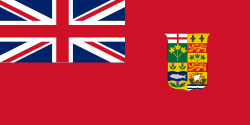 Dominion of Canada
Dominion of Canada
- Robert Borden – Prime Minister of Canada (1914–18)
- Sam Hughes – Minister of Militia and Defence (1914 – January 1915)
- Joseph Flavelle – Chairman of Imperial Munitions Board (1915–19)
-
 Lieutenant-General Edwin Alderson – Commander of the unified Canadian Corps of the Canadian Expeditionary Force (26 January 1915 – September 1915)
Lieutenant-General Edwin Alderson – Commander of the unified Canadian Corps of the Canadian Expeditionary Force (26 January 1915 – September 1915) -
 General Julian Byng – Commander of the unified Canadian Corps of the Canadian Expeditionary Force (June 1916 – June 1917)
General Julian Byng – Commander of the unified Canadian Corps of the Canadian Expeditionary Force (June 1916 – June 1917) - General Arthur Currie – Commander of the unified Canadian Corps of the Canadian Expeditionary Force (June 1917 –)[41]
 Commonwealth of Australia
Commonwealth of Australia
- Joseph Cook – Prime Minister of Australia (until 17 September 1914)
- Andrew Fisher – Prime Minister of Australia (17 September 1914 – 27 October 1915)
- Billy Hughes – Prime Minister of Australia (from 27 October 1915)
-
 General William Birdwood – Commander of the Australian Corps (all five Australian infantry divisions serving on the Western Front) (November 1917 – May 1918)
General William Birdwood – Commander of the Australian Corps (all five Australian infantry divisions serving on the Western Front) (November 1917 – May 1918) - General John Monash – Commander of the Australian Corps (May 1918 –)
- Major General William Holmes – Commander of the Australian Naval and Military Expeditionary Force (August 1914 – February 1915)
- General Harry Chauvel – Commander of Desert Mounted Corps (Sinai and Palestine) (August 1917 –)
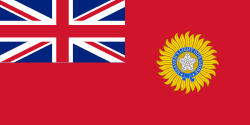 Empire of India
Empire of India
- Charles Hardinge, 1st Baron Hardinge of Penshurst – Viceroy of India 1910–1916
- Frederic Thesiger, 1st Viscount Chelmsford – Viceroy of India 1916–1921
- Robert Crewe-Milnes, 1st Marquess of Crewe – Secretary of State for India (May 1911 – May 1915)
- Austen Chamberlain – Secretary of State for India (May 1915 – July 1917)
- Edwin Samuel Montagu – Secretary of State for India (July 1917 – March 1922)
- Lieutenant-General John Nixon commander of the British Indian Army (active in the Middle East)
.svg.png) Union of South Africa
Union of South Africa
- General Louis Botha – Prime Minister of South Africa
- General Jan Smuts – Led forces in South-West Africa Campaign and East African Campaign, later member of the Imperial War Cabinet
 New Zealand
New Zealand
- William Massey – Prime Minister of New Zealand
- General Sir Alexander Godley – Commandant of New Zealand Military Forces (to October 1914); Commander of the New Zealand Expeditionary Force
- Major General Sir Alfred William Robin – Quartermaster-General and Commandant of New Zealand Military Forces (from October 1914)
- Major General Sir Andrew Hamilton Russell – Commander of the New Zealand Division
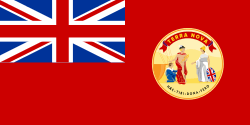 Dominion of Newfoundland
Dominion of Newfoundland
- Sir Edward Morris – Prime Minister of Newfoundland (1909–1917)
- Sir John Crosbie – Prime Minister of Newfoundland (1917–1918)
- Sir William Lloyd – Prime Minister of Newfoundland (1918–1919)
.svg.png) Japan
Japan
- Emperor Taishō – Emperor of Japan
- Ōkuma Shigenobu – Prime Minister of Japan (16 April 1914 – 9 October 1916)
- Terauchi Masatake – Prime minister of Japan (9 October 1916 – 29 September 1918)
- Hara Takashi – Prime minister of Japan (29 September 1918 – 4 November 1921)
- Kōzō Satō – Commander of the Second Special Task Fleet
- Kamio Mitsuomi – Commander of Allied land forces at Tsingtao
_crowned.svg.png) Italy (1915–1918)
Italy (1915–1918)
- Victor Emmanuel III – King of Italy
- Antonio Salandra – Prime Minister (until 18 June 1916)
- Paolo Boselli – Prime Minister (18 June 1916 – 29 October 1917)
- Vittorio Emanuele Orlando – Prime Minister (from 29 October 1917)
- Luigi Cadorna – Commander-in-Chief of the Royal Italian Army
- Armando Diaz – Chief of General Staff of the Royal Italian army
- Luigi, Duke of Abruzzi – Commander-in-Chief of the Adriatic Fleet of Italy (1914–17)
- Paolo Thaon di Revel – Admiral of the Royal Italian Navy
 Romania (1916–1918)
Romania (1916–1918)
- Ferdinand I – King of Romania
- General Constantin Prezan – Chief of the General Staff of Romania
- Ion I. C. Brătianu – Prime Minister of Romania
- Vintilă Brătianu – Secretary of War
- Field Marshal Alexandru Averescu – Commander of the 2nd Army, 3rd Army, then Army Group South
- General Eremia Grigorescu – Commander of the 1st Army
.svg.png) Greece (1917–1918)
Greece (1917–1918)
- Eleftherios Venizelos: Prime minister of Greece after 13 June 1917.
- Constantin I: King of Greece, he retired from the throne, without formally resigning.
- George: Crown Prince of Greece, designated King after his father retired from the throne, he refused to become the new king and followed his father in exile.
- Alexander: King of Greece, he became King of Greece after his father and brother retired from the throne.
- Panagiotis Danglis: Greek general in the Hellenic Army.
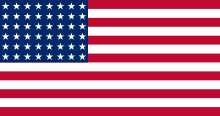 United States (1917–1918)
United States (1917–1918)

- Woodrow Wilson – President of the United States/Commander-In-Chief of the U.S. armed forces
- Newton D. Baker – U.S. Secretary of War
- Josephus Daniels – United States Secretary of the Navy
- Major General / General John J. Pershing – Commander of the American Expeditionary Force
- Rear Admiral / Vice Admiral William Sims – Commander of U.S. Naval Forces in European Waters
- Brigadier General Mason Patrick – Commander of the United States Army Air Service
 Portugal (1917–1918)
Portugal (1917–1918)
- Bernardino Machado – President of Portugal (until 12 December 1917)
- Afonso Costa – Prime Minister of Portugal (until 15 March 1916; then again 25 April 1917 – 10 December 1917)
- António José de Almeida – Prime Minister of Portugal (15 March 1916 – 25 April 1917)
- Sidónio Pais – Prime Minister of Portugal and War Minister (11 December 1917 – 9 May 1918) and President of Portugal (from 9 May 1918)
- José Norton de Matos – War Minister (until 10 December 1917)
- João Tamagnini Barbosa – Interim War Minister (9 May 1918 – 15 May 1918)
- Amílcar Mota – Secretary of State for War (15 May 1918 – 8 October 1918)
- Álvaro de Mendonça – Secretary of State for War (from 8 October 1918)
- Fernando Tamagnini de Abreu – Commander of the Portuguese Expeditionary Corps (CEP)
- José Augusto Alves Roçadas – Commander of the Portuguese Forces in Southern Angola
- José Luís de Moura Mendes – Commander of the Portuguese Forces in Eastern Africa (until June 1916)
- José César Ferreira Gil – Commander of the Portuguese Forces in Eastern Africa (from June 1916)
- Sousa Rosa – Commander of the Portuguese Forces in Eastern Africa (from 1917)

 Siam (Thailand) (1917–1918)
Siam (Thailand) (1917–1918)
See main Article: Siam in World War I
- Rama VI – King of Siam
- Field Marshal Chao Phraya Bodindechanuchit – Minister of Defence
- Prince Chakrabongse Bhuvanath – Supreme Commander Siamese Expeditionary Forces in World War I
- General Phraya Bijai Janriddhi – Commander of Siamese Expeditionary Forces in Western Front
 Brazil (1917–1918)
Brazil (1917–1918)
See main Article: Brazil during World War I
- Venceslau Brás – President of Brazil
- Admiral Pedro Frontin, Chief of DNOG (Brazilian Expeditionary Fleet)
- General Napoleão Felipe Aché, Chief of Brazilian Military Mission in France (1918–1919)
- M.D. Nabuco Gouveia – Chief of Brazilian Military Medical Commission
 Armenia (1918)
Armenia (1918)
- Andranik – military commander and statesman of the Caucasus Campaign
- Aram Manukian – Minister of Internal Affairs of Armenia
- Drastamat Kanayan – Military commander and member of the Armenian Revolutionary Federation
- Tovmas Nazarbekian – Commander-in-chief of the Armenian Republic
- Movses Silikyan – Army general and National hero
Personnel and casualties

These are estimates of the cumulative number of different personnel in uniform 1914–1918, including army, navy and auxiliary forces. At any one time, the various forces were much smaller. Only a fraction of them were frontline combat troops. The numbers do not reflect the length of time each country was involved. (See also: World War I casualties)
| Allied power | Mobilized personnel | Military Fatalities | Wounded in action | Total casualties | Casualties as % of total mobilized |
|---|---|---|---|---|---|
| Australia | 412,9531 | 61,928[42] | 152,171 | 214,099 | 52% |
| Belgium | 267,0003 | 38,172[43] | 44,686 | 82,858 | 31% |
| Canada | 628,9641 | 64,944[44] | 149,732 | 214,676 | 34% |
| France | 8,410,0003 | 1,397,800[45] | 4,266,000 | 5,663,800 | 67% |
| Greece | 230,0003 | 26,000[46] | 21,000 | 47,000 | 20% |
| India | 1,440,4371 | 74,187[47] | 69,214 | 143,401 | 10% |
| Italy | 5,615,0003 | 651,010[48] | 953,886 | 1,604,896 | 29% |
| Japan | 800,0003 | 415[49] | 907 | 1,322 | <1% |
| Monaco | 80[50] | 8[50] | 0 | 8[50] | 10% |
| Montenegro | 50,0003 | 3,000 | 10,000 | 13,000 | 26% |
| Nepal | 200,000[51] | 30,670 | 21,009 | 49,823 | 25% |
| New Zealand | 128,5251 | 18,050[52] | 41,317 | 59,367 | 46% |
| Portugal | 100,0003 | 7,222[53] | 13,751 | 20,973 | 21% |
| Romania | 750,0003 | 250,000[54] | 120,000 | 370,000 | 49% |
| Russia | 12,000,0003 | 1,811,000[55] | 4,950,000 | 6,761,000 | 56% |
| Serbia | 707,3433 | 275,000[56] | 133,148 | 408,148 | 58% |
| Siam | 1,2842 | 19 | 0 | 19 | 2% |
| South Africa | 136,0701 | 9,463[57] | 12,029 | 21,492 | 16% |
| United Kingdom | 6,211,9222 | 886,342[58] | 1,665,749 | 2,552,091 | 41% |
| United States | 4,355,0003 | 116,708[59] | 205,690 | 322,398 | 7% |
| Total | 42,244,409 | 5,741,389 | 12,925,833 | 18,744,547 | 49% |
Summary of Declarations of War
The following table shows the timeline of the several declarations of war among the belligerent powers. Entries on a yellow background show severed diplomatic relations only, not actual declarations of war. Unless stated otherwise, declarations of war by and on the United Kingdom include de facto declarations by and on other members of the British Empire.
| Date | Declarer | On |
|---|---|---|
| 1914 | ||
| 28 July | |
|
| 1 August | |
|
| 3 August | |
|
| 4 August | |
|
| |
| |
| 5 August | |
|
| 6 August | |
|
| |
| |
| 9 August | |
|
| 11 August | |
|
| 12 August | |
|
| 22 August | |
|
| 23 August | |
|
| 25 August | |
|
| 1 November | |
|
| 2 November | |
|
| 3 November | |
|
| 5 November | |
|
| 1915 | ||
| 23 May | |
|
| 3 June | |
|
| 21 August | |
|
| 14 October | |
|
| 15 October | |
|
| 16 October | |
|
| 19 October | |
|
| 1916 | ||
| 9 March | |
|
| 15 March | |
|
| 27 August | |
|
| |
| |
| 28 August | |
|
| 30 August | |
|
| 1 September | |
|
| 1917 | ||
| 6 April | |
|
| 7 April | |
|
| 10 April | |
|
| 13 April | |
|
| 20 April | |
|
| 2 July | |
|
| 22 July | |
|
| 4 August | |
|
| 14 August | |
|
| 6 October | |
|
| 7 October | |
|
| 26 October | |
|
| 7 December | |
|
| 7 December | |
|
| 10 December | |
|
| 16 December | |
|
| 1918 | ||
| 23 April | |
|
| 8 May | |
|
| 23 May | |
|
| 12 July | |
|
| 19 July | |
|
| 10 November | |
|
See also
- Triple Entente
- Participants in World War I
- Central Powers
- Allied leaders of World War I
- Allies of World War II
Footnotes
- ↑ Karel Schelle, The First World War and the Paris Peace Agreement, GRIN Verlag, 2009, p. 24
- ↑ First World War.com – Feature Articles – The Causes of World War One
- ↑ The Treaty of Sèvres, 1920
- 1 2 US Declaration of War
- ↑ Declarations of War and Authorizations for the Use of Military Force: Historical Background and Legal Implications
- ↑ H.J.Res.169: Declaration of War with Austria-Hungary, WWI, United States Senate
- 1 2 Tucker&Roberts pp. 1232, 1264
- 1 2 Tucker&Roberts p. 1559
- ↑ Perry (2004), p.xiii
- ↑ S.N. Broadberry; Mark Harrison (2005). The Economics of World War I. illustrated. Cambridge University Press. p. 7. Retrieved 2015-03-16.
- ↑ Korea, Formosa, Kwantung and Sakhalin
- ↑ Serbia, Montenegro and Bosnia-Hercegovina
- ↑ As Hawaii and Alaska were not yet U.S. states, they are included in the dependencies
- ↑ Costa Rica, Cuba, Guatemala, Haiti, Honduras, Nicaragua and Panama
- ↑ S.N. Broadberry; Mark Harrison (2005). The Economics of World War I. illustrated. Cambridge University Press. p. 8. Retrieved 2015-03-16.
- ↑ Germany (and colonies), Austria-Hungary, Ottoman Empire and Bulgaria
- ↑ Tucker, Spencer C. A Global Chronology of Conflict: From the Ancient World to the Modern Middle East: From the Ancient World to the Modern Middle East. ABC-CLIO. 2009. P1562.
- 1 2 3 Jelavich, Barbara. Russia's Balkan Entanglements, 1806–1914. P262
- ↑ Afflerbach, Holger; David Stevenson, David. An Improbable War: The Outbreak of World War 1 and European Political Culture. Berghan Books. 2012. P. 293.
- ↑ Tucker, Spencer C. A Global Chronology of Conflict: From the Ancient World to the Modern Middle East: From the Ancient World to the Modern Middle East. ABC-CLIO. 2009. P1556.
- 1 2 3 Hamilton, Richard F; Herwig, Holger H. Decisions for War, 1914–1917. P155.
- 1 2 3 4 5 Hamilton, Richard F; Herwig, Holger H. Decisions for War, 1914–1917. P194.
- 1 2 Hamilton, Richard F; Herwig, Holger H. Decisions for War, 1914–1917. P194-198.
- ↑ Charles Upson Clark, United Roumania, p. 135
- ↑ Spencer C. Tucker, Pricilla Mary Roberts, Encyclopedia of World War I, p. 273
- ↑ Adrian Storea, Gheorghe Băjenaru, Artileria română în date și imagini (Romanian artillery in data and pictures), pp. 40, 49, 50, 54, 59, 61, 63, 65 and 66 (in Romanian)
- ↑ Jozef Wilczynski, Technology in Comecon: Acceleration of Technological Progress Through Economic Planning and the Market, p. 243
- ↑ International Naval Research Organization, Warship International, Volume 21, p. 160
- ↑ Frederick Thomas Jane, Jane's Fighting Ships, p. 343
- ↑ Robert Gardiner, Conway's All the World Fighting Ships 1906–1921, p. 422
- ↑ Adrian Storea, Gheorghe Băjenaru, Artileria română în date și imagini (Romanian artillery in data and pictures), p. 53 (in Romanian)
- ↑ Martin Gilbert, The First World War: A Complete History, p. 282
- ↑ Glenn E. Torrey, Romania and World War I, p. 58
- ↑ Michael Hundertmark, Holger Steinle, Phoenix aus der Asche – Die Deutsche Luftfahrt Sammlung Berlin, pp. 110–114 (in German)
- ↑ România în anii primului război mondial (Romania int he years of the First World War), Volume II, p. 830 (in Romanian)
- ↑ Martin Gilbert, The First World War: A Complete History, p. 287
- ↑ King of Battle: Artillery in World War I, p. 347
- ↑ Angus Konstam, Gunboats of World War I, p. 29
- ↑ René Greger, Austro-Hungarian warships of World War I, p. 142
- ↑ Abdullah I of Jordan; Philip Perceval Graves (1950). Memoirs. p. 186.
- ↑ first Canadian to attain the rank of full general
- ↑ Australia casualties
Included in total are 55,000 killed or missing in action and died of wounds6,85-.
The Commonwealth War Graves Commission Annual Report 2005-2006 is the source of total military dead.4-
Totals include 2,005 military deaths during 1919–215-. The 1922 War Office report listed 59,330 Army war dead1,237. - ↑ Belgium casualties
Included in total are 35,000 killed or missing in action and died of wounds6,85 Figures include 13,716 killed and 24,456 missing up until Nov.11, 1918. "These figures are approximate only, the records being incomplete." 1,352. - ↑ Canada casualties
Included in total are 53,000 killed or missing in action and died of wounds.6,85
The Commonwealth War Graves Commission Annual Report 2005-2006 is the source of total military dead.4
Totals include 3,789 military deaths during 1919–21 and 150 Merchant Navy deaths5-. The losses of Newfoundland are listed separately on this table. The 1922 War Office report listed 56,639 Army war dead1,237. - ↑ France casualties
Included in total are 1,186,000 killed or missing in action and died of wounds6,85. Totals include the deaths of 71,100 French colonial troops. 7,414-Figures include war related military deaths of 28,600 from 11/11/1918 to 6/1/1919.7,414 - ↑ Greece casualties
Jean Bujac in a campaign history of the Greek Army in World War One listed 8,365 combat related deaths and 3,255 missing8,339, The Soviet researcher Boris Urlanis estimated total dead of 26,000 including 15,000 military deaths due disease6,160 - ↑ India casualties
British India included present-day India, Pakistan and Bangladesh.
Included in total are 27,000 killed or missing in action and died of wounds6,85.
The Commonwealth War Graves Commission Annual Report 2005-2006 is the source of total military dead.4
Totals include 15,069 military deaths during 1919–21 and 1,841 Canadian Merchant Navy dead5. The 1922 War Office report listed 64,454 Army war dead1,237 - ↑ Italy casualties
Included in total are 433,000 killed or missing in action and died of wounds6,85
Figures of total military dead are from a 1925 Italian report using official data9. - ↑ War dead figure is from a 1991 history of the Japanese Army10,111.
- 1 2 3 Monaco 11-Novembre : ces Monégasques morts au champ d'honneur | Nice-Matin
- ↑ Jain, G (1954) India Meets China in Nepal, Asia Publishing House, Bombay P92
- ↑ New Zealand casualties
Included in total are 14,000 killed or missing in action and died of wounds6,85.
The Commonwealth War Graves Commission Annual Report 2005-2006 is the source of total military dead.4
Totals include 702 military deaths during 1919–215. The 1922 War Office report listed 16,711 Army war dead1,237. - ↑ Portugal casualties
Figures include the following killed and died of other causes up until Jan.1, 1920; 1,689 in France and 5,332 in Africa. Figures do not include an additional 12,318 listed as missing and POW1,354. - ↑ Romania casualties
Military dead is "The figure reported by the Rumanian Government in reply to a questionnaire from the International Labour Office"6,64. Included in total are 177,000 killed or missing in action and died of wounds6,85. - ↑ Russia casualties
Included in total are 1,451,000 killed or missing in action and died of wounds6,85. The estimate of total Russian military losses was made by the Soviet researcher Boris Urlanis.6,46–57 - ↑ Serbia casualties
Included in total are 165,000 killed or missing in action and died of wounds6,85.The estimate of total combined Serbian and Montenegrin military losses of 278,000 was made by the Soviet researcher Boris Urlanis6,62–64 - ↑ South Africa casualties
Included in total are 5,000 killed or missing in action and died of wounds6,85
The Commonwealth War Graves Commission Annual Report 2005-2006 is the source of total military dead.4
Totals include 380 military deaths during 1919–2115. The 1922 War Office report listed 7,121 Army war dead1,237. - ↑ UK and Crown Colonies casualties
Included in total are 624,000 killed or missing in action and died of wounds6,85.
The Commonwealth War Graves Commission Annual Report 2005-2006 is the source of total military dead.4
Military dead total includes 34,663 deaths during 1919–21 and 13,632 British Merchant Navy deaths5. The 1922 War Office report listed 702,410 war dead for the UK1,237, 507 from "Other colonies"1,237 and the Royal Navy (32,287)1,339.
The British Merchant Navy losses of 14,661 were listed separately 1,339; The 1922 War Office report detailed the deaths of 310 military personnel due to air and sea bombardment of the UK1,674–678. - ↑ United States casualties
Official military war deaths listed by the US Dept. of Defense for the period ending Dec. 31, 1918 are 116,516; which includes 53,402 battle deaths and 63,114 other deaths., The US Coast Guard lost an additional 192 dead 11,481. - ↑ Declarations of War, 1914–1918
References
- ^1 The War Office (2006) [1922]. Statistics of the military effort of the British Empire during the Great War 1914—1920. Uckfield, East Sussex: Military and Naval Press. ISBN 1-84734-681-2. OCLC 137236769.
- ^2 Gilbert Martin (1994). Atlas of World War I. Oxford University Press. ISBN 0-19-521077-8. OCLC 233987354.
- ^3 Tucker Spencer C (1999). The European Powers in the First World War: An Encyclopedia. New York: Garland. ISBN 0-8153-3351-X.
- ^4 The Commonwealth War Graves Commission. "Annual Report 2005-2006" (PDF).
- ^5 The Commonwealth War Graves Commission. "Debt of Honour Register".
- ^6 Urlanis Boris (2003) [1971, Moscow]. Wars and Population. Honolulu: University Press of the Pacific. OCLC 123124938.
- ^7 Huber Michel (1931). La population de la France pendant la guerre, avec un appendice sur Les revenus avant et après la guerre (in French). Paris. OCLC 4226464.
- ^8 Bujac Jean Léopold Emile (1930). Les campagnes de l'armèe Hellènique 1918–1922 (in French). Paris: Charles-Lavauzelle. OCLC 10808602.
- ^9 Mortara Giorgio (1925). La Salute pubblica in Italia durante e dopo la Guerra (in Italian). New Haven, Connecticut: Yale University Press. OCLC 2099099.
- ^10 Harries Merion, Harries Susie (1991). Soldiers of the Sun – The Rise and Fall of the Imperial Japanese Army. Random House. ISBN 0-679-75303-6. OCLC 32615324.
- ^11 Clodfelter Michael (2002). Warfare and Armed Conflicts : A Statistical Reference to Casualty and Other Figures, 1500–2000 (2nd ed.). London: McFarland. ISBN 0-7864-1204-6. OCLC 48066096.
Sources
- Ellis, John and Mike Cox. The World War I Databook: The Essential Facts and Figures for All the Combatants (2002)
- Esposito, Vincent J. The West Point Atlas of American Wars: 1900–1918 (1997) despite the title covers entire war; online maps from this atlas
- Falls, Cyril. The Great War (1960), general military history
- Higham, Robin and Dennis E. Showalter, eds. Researching World War I: A Handbook (2003), historiography, stressing military themes
- Pope, Stephen and Wheal, Elizabeth-Anne, eds. The Macmillan Dictionary of the First World War (1995)
- Strachan, Hew. The First World War: Volume I: To Arms (2004)
- Trask, David F. The United States in the Supreme War Council: American War Aims and Inter-Allied Strategy, 1917–1918 (1961)
- Tucker, Spencer, ed. The Encyclopedia of World War I: A Political, Social, and Military History (5 volumes) (2005), online at eBook.com
- Tucker, Spencer, ed. European Powers in the First World War: An Encyclopedia (1999)